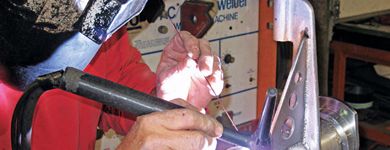
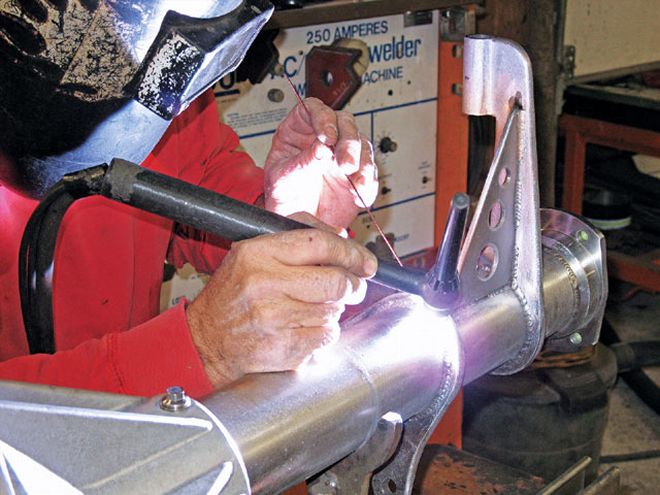 Dennis Lesky of the Ionia hot Rod Shop lays down some beautiful beads welding brackets on a Speedway quick-change.
Dennis Lesky of the Ionia hot Rod Shop lays down some beautiful beads welding brackets on a Speedway quick-change.
If a standardized parts list for hot rods were ever developed, no doubt one of the components on it would be a quick-change. these race-bred rearends don't just offer the obvious practical benefit of allowing the final drive ratio to be optimized for every conceivable need. along with mechanical flexibility, they also provide a street rod with attitude, their visual impact is undeniable, and, to the true enthusiast, their characteristichowl is music to the ears.
While there have been a few exceptions, most quickchange rears are similar in layout with removable gears at the rear of the case. generally, the smaller-style center sections use six-spline gears, while the larger versions use 10-splines; some gears are straight-cut while others are helical. Helical gears are normally quieter, but they apply more thrust loads to the case and cover. Despite the number of splines or the design of the teeth, all quick-change gears come in pairs and have a universal numbering system. With the selection of gear sets available, final drive ratios from less than 2:1 to more than 9:1-and almost everything in between-are possible; that's why racers have boxes of gear sets. however, just one pair of gears can offer surprising flexibility; with a single number-3 set (one 25- and one 31-tooth spur gears), either a 3.38:1 or 4.11:1 gear ratio can be had with a 3.78:1 ring-and-pinion just by flipping around the gears.
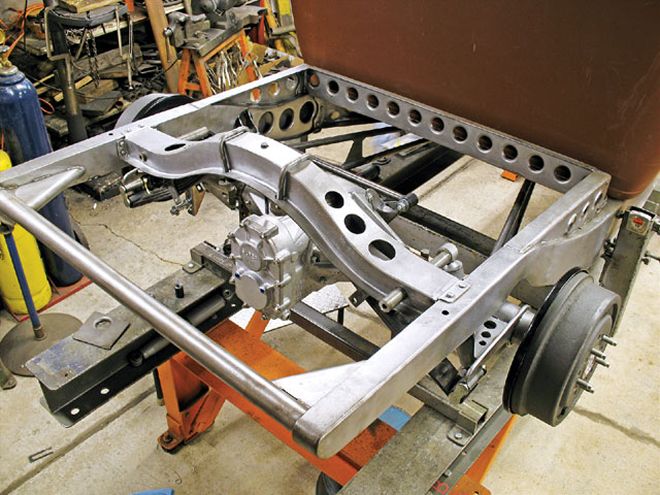 If real hot rods have lightening holes and quick-changes, the Model a roadster pickup is the genuine article. the framework is to support the pickup bed; note the trick gussets on rear of the bobbed rails.
If real hot rods have lightening holes and quick-changes, the Model a roadster pickup is the genuine article. the framework is to support the pickup bed; note the trick gussets on rear of the bobbed rails.
Over the years, there has been considerable debate over the origin of the quick-change. One thing's for sure, the first were not made of aluminum but rather original Ford banjos. Virtually all builders of these fabricated quick-changes used the same procedure: the center section was turned around and upside down, and the original pinion gear was retained but modified to accept a support bearing and a removable spur gear where the driveshaft coupler once attached. a lower housing was added to accommodate a shaft that hooked to the driveshaft, ran past the ring gear, and held a second removable spur gear. (Some early quick-changes used sprockets and a chain, rather than gears.)
A considerable amount of modification and welding was done to the original center section to house the lower shaft and mount the rear cover, and, as might be expected, some were crude while others were works of art. Still, they all had one thing in common: Fabricated quick-changes were very labor-intensive and expensive to produce. It's been estimated that as many as 30 different brands of Ford-based quickchanges have been produced over the years, carrying such names as Bart-Bilt, David, Frankland, Franklin, highland, Monroe, and a string of others. according to the late Bruce Johnston, a longtime SoCal hot rodder and racer, Ernie Lauck of Fresno, California, created the first aluminum quick-change. Johnston also acknowledged his friend, ted halibrand, as the man who refined the design and turned them into a viable and successful product.
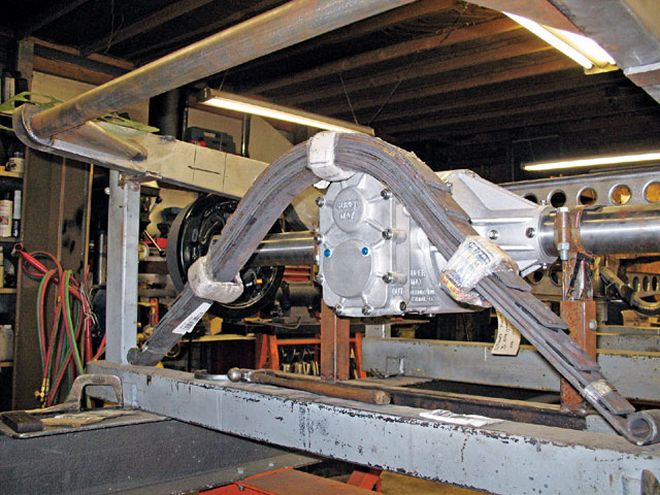 To begin the installation, the boys at Ionia mount the 'rails in a jig; the quick-change is then put in a fixture that positions it appropriately for the proper ride height.
To begin the installation, the boys at Ionia mount the 'rails in a jig; the quick-change is then put in a fixture that positions it appropriately for the proper ride height.
One of the major players in the contemporary racing quick-change arena is Speedway Engineering. and, while the name may be somewhat new to street rodders, Speedway Engineering has been heavily involved in racing for more than 35 years, and its products can be found throughout the ranks of NaSCaR, aRCa, and virtually every other racing association. Speedway offers a variety of suspension and drivetrain products for racers and street rodders alike, including the company's Mini-Stock and Super Max quickchange rearends. While the Mini-Stock moniker makes it sound like it's a small rearend, it's actually the perfect size for ts to Deuce highboys. Found under a number of 300-plus-mph Bonneville cars, it's also strong enough for most street rod applications. For those with heavy or extremely high-powered rods, or if you just prefer the mass of a Champ-style rear, Speedway offers the Super Max. and if you want an IRS, Speedway can accommodate that, too, based on either a Mini-Stock or Super Max center section.
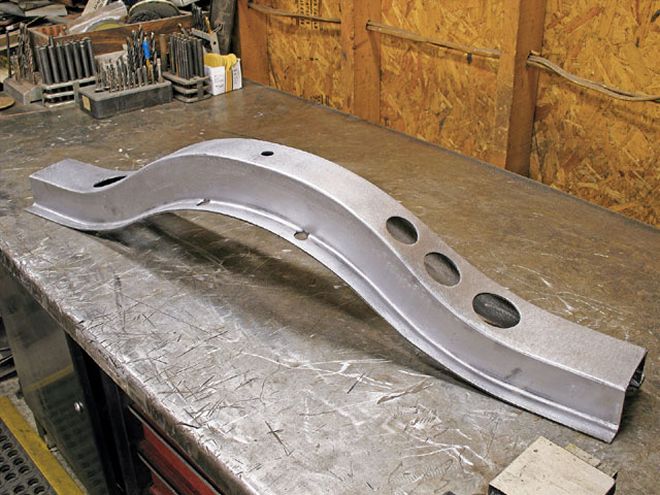 A repop Model a rear crossmember was to be used, but Dennis and Matt gave it a unique look by ventilating it with various size holes.
A repop Model a rear crossmember was to be used, but Dennis and Matt gave it a unique look by ventilating it with various size holes.
Recently we caught our old friends Dennis and Matt Lesky, of the Ionia hot Rod Shop, in the act of installing a Speedway Engineering Super Max quick-change under a Model a roadster pickup. In typical Lesky fashion, the Ionians have elevated the fairly common exercise of installing a rearend to a veritable art form, and we were lucky enough to be able to follow along. however, it was necessary to rustle up a few more parts before the changer could be put in place.
We relied on Dutchman Motorsports for axles. as the experts at Dutchman explained it, most stock (OEM) axles are made from 1039 material and are induction, or casehardened to a .150-inch depth with a hardness of 52-54 Rockwell C scale. Dutchman uses one-piece forgings made from 1541-h material, with a case-hardening depth of .300-.350- inch and a hardness of 57-60 Rockwell C scale. the result is a stronger-thanstock street and strip alloy axle with unique properties. the hard case and soft core design enable the shaft to bend, flex, and spring back. Properly executed, both chrome-moly throughhardened and an upgraded inductionhardened shafts can achieve the same results in strength in the critical areas of torsional strength and life cycles, while an induction-hardened shaft usually yields more bending (life) cycles than a through-hardened shaft. todd went on to point out that axleshafts often warp and bow during heat treating. For this reason, Dutchman machines all the critical areas (splines, bearing journal, flange face, and brake pilot) after the heat-treat process. the splines are machined to the correct pressure angle for the particular application, typically 30 or 45 degrees, and most manufacturing engineers will concur with this method of production. All axles are custom made to order with a choice of length, spline, and most popular bolt patterns. In addition, the non-tapered shaft design allows for shortening, and the ductile iron flanges allow for an additional bolt pattern if needed.
A variety of brake packages are available for the Speedway rearend; drum brakes were deemed appropriate in this application, so complete assemblies with all new parts were ordered from Dutchman.
With the axles, brakes, and quickchange assembled, Dennis and Matt went about putting it in place. as we've come to expect, the installation was as first-class as the components used. Take a look and see if you don't agree.